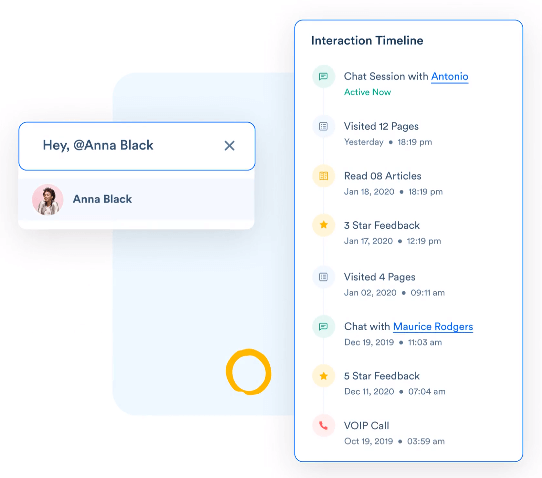6 ways to care more about customers than the sale
The 6 best ways to show customers you care
Companies that customers love to do business with have something in common. They all value their customers over their sales. It’s natural for them to want to make the sale and increase revenue, but it only works out if they solve the problem their customers bring without showing that it’s all about the money.
Updated on Jun 23, 2021
1. Make the conversation hyper-personalized
Personalization is the single most effective and astonishingly simple way to become more customer-centric and keep your retention rate high. Remember visitors with cookies if you have a website. Keep track of the products they prefer and how much time they spend on each page, the frequency of page visits, and so on. Data like this will come in handy when they request support.
Even offline, making a connection with your customers beyond what you’re trying to sell will make you memorable. It’s the little things — remember their first names, say “thank you”, and so on.
Customers enjoy being treated as regulars in a store they visit often, and this also applies to online shops. Seeing your customers as humans, and not as statistics, will allow you to deliver exemplary customer service.
2. Invest in live chat software for real-time support
Customer care is the structure over which your entire business rests. According to American Express, more than 66% of customers are willing to spend more with brands that provide better customer care. Live chat, it turns out, is an integral part of providing a great customer experience and for various reasons. Taking advantage of live chat can optimize customer support in the following ways:
Boosts efficiency: Running ads might increase your conversions temporarily, but this strategy is not enough for sustainable growth. Yes, the conversion rate is a crucial KPI, for profitability, but you need to factor in efficient customer service as well. You can hit the sweet spot here by using live chat support software. It’s 20-50% cheaper than phone support and saves everyone’s time.
- Increases customer satisfaction: Everyone loves live chat support, and it’s proven by surveys as well. Live chat has customer satisfaction rates of over 90%, and it shouldn’t come as a surprise. It’s fast, it’s free, conversational, and user-friendly.
- Personalizes customer experience: Live chat allows you to gather customer data, today’s most valuable resource. By adding a face to your brand, this data will allow you to get closer to your customers. Personalized experiences can penetrate the thick layer of cyberspace between you and them.
Live chat works for businesses of all kinds and gives your brand a human feel. Even the transcripts can later be used to train your agents to provide even better customer care.
3. Show respect to customers
If you’re all about providing great customer care, respecting your customers is paramount. Lately, companies have been asking too much of their consumers — especially their data, without offering much in return. As such, it’s imperative to take a customer-centric approach and build a relationship that’s mutually beneficial. Here are some ideas:
- Solve their problems: Going out of your way to solving customer problems is perhaps the best way to show that you care about them. Acknowledge the issue they’re facing, apologize for it, fix it ASAP, and make sure it never happens again.
- Ask for permission to collect their data: Regardless of whether you’re connecting with your customers via email, phone, or over the web, you need to ask for permission to collect their data. Being attentive here goes a long way to show that you respect their privacy.
- Keep your promises: Assuring your customer of something and failing to do it is a disaster. If you’ve given a time frame to resolve a certain issue, get it done within that period. Taking swift action shows you respect their time and creates a sense of respect for your service.
There are many subtle ways through which you can show respect for your customers. Responding promptly, taking ownership of your mistakes, and treating them the way you’d like to be treated are some of the other ways you can make customers feel valued.
4. Implement a customer-centric strategy across the organization
Young business professionals and entrepreneurs put a lot of effort into planning their ventures — the products and services they’ll offer and how they plan to be profitable. In this rush, they often become too focused on their inner workings and lose sight of what the customer needs.
On the other hand, for any sales-oriented business, focusing on a more customer-centric approach is the go-to move. In any case, the customer must be in the driver’s seat if you’re looking to build and nurture long-term relationships. This involves offering an exemplary customer experience both before and after the sale. But that’s not all — according to Deloitte, customer-centric businesses are 60 percent more profitable.
With that in mind, here are a few things you can do:
- Understand your audience: Extensive user research should be the first step towards creating a customer-centric experience. You’ll need to collect insights from every platform your customers use to interact with your brand. You can’t meet their demands unless you know what they want.
- Leverage multichannel marketing: It’s always better to be present on multiple platforms, so it’s easier for your customers to reach you and engage with your brand. Addressing brand-related queries on platforms including social media hints at a customer-centric mindset.
- Define your customer-oriented approach: Develop a CX strategy from user research insights, then take action to improve customer experience.
For your business to succeed, you need to put the customer at the core of everything you do, tailoring everything the way your target audience likes it.
5. Show gratitude
ECommerce giants like Amazon have a no-questions-asked return policy. More than convenience, this is rewarding for any loyal customer and reflects gratitude on the company’s part.
But if you’re a growing business, even a handwritten note sent to your customers will bring a broad smile to their faces. The note can be as simple as wishing the customer a good day, but it will make your service seem personal, and customers will feel like they matter more than their money. It’s all about developing the customer-centric mindset and making them feel important. On a similar note, you can also send them wishes on their special occasions, such as their birthdays or anniversaries, or when your company achieves a milestone and you would like to thank those who have been a part of the journey.
You can also offer your loyal customers an extension of service (or free service) during challenging times like the pandemic. Loom, for instance, decided not to profit from the pandemic and offered their shareable video software to institutions for free, allowing them to work remotely.
But those cases will be rare. Being grateful shouldn’t be. While some companies shower their customers with swag, a thoughtful gift at the end of the purchase is enough to set you apart. It is a tried-and-true strategy to offer post-purchase discounts or gift certificates valid for their next purchase. But a budget and a process that can be repeated are equally important.
6. Ask for their feedback
The majority of your customers would like to give suggestions and provide feedback and ideas for improving your product, service, and overall customer experience. All you need to do is ask. Asking for their feedback implies you value their opinions and are willing to look at the areas they identify as lacking. If you have any new plans or are introducing a new product, it’s always a good idea to share it with your most loyal customers.

It’s not only for show – nothing is more reliable for learning about a company’s quality than feedback from customers themselves. In addition to highlighting the aspects of your products and services that need improvement, it indicates which ones don’t – what worked for the customer, which was their least favorite, and why.
Listening to customer feedback makes them feel more involved in your process, almost as if they are part of your team.
There is only one caveat – you must discuss every feedback with your team and revert the results to your customers so as not to leave them in the dark. Remember that every positive experience that a customer has is directed right back at you.
Conclusion
Customers come by hard and are easy to lose. Following the points mentioned above, like building a customer-centric mindset and using live chat for customer care, you will never lose a customer again from your own fault. Your problems will change from having a low customer lifetime value (CLV) or a high bounce rate to having too many customers. We all look forward to these types of problems.




















